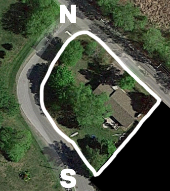








I make a Maple Syrup instructional movie! Check it out HERE
SKIP books, get 'em while they're hot!!! Skills to Inherit Property
See me in a movie building a massive wood staircase:Low Tech Lab Movie








Sometimes the answer is nothing

 3
3








 1
1




I make a Maple Syrup instructional movie! Check it out HERE
SKIP books, get 'em while they're hot!!! Skills to Inherit Property
See me in a movie building a massive wood staircase:Low Tech Lab Movie




Miles Flansburg wrote:Mark, I am looking forward to seeing if your creative bandage works . An apple for your out of the box thinking!
Mike Jay wrote:If it wasn't going to make it, the splint won't have made things worse. If it was going to make it, the splint will probably help. So it was a win win (in a way).
I'd still protect it from deer (or children?). I just don't see a light storm causing that large a twig to break, especially with the bark stripping.




I make a Maple Syrup instructional movie! Check it out HERE
SKIP books, get 'em while they're hot!!! Skills to Inherit Property
See me in a movie building a massive wood staircase:Low Tech Lab Movie




Mike Jay wrote:Did any of the leaves get eaten? If not, I'll retract the deer premise. They usually break branches in the act of pulling leaves off of trees (especially my cherry trees). So if you don't have any leaf damage, it probably isn't a deer. Did the broken spot get "broken" as if it was bent until it broke? Or was there damage at the break like a critter nibbled and weakened it?
Unless that was a weak spot in the tree (unlikely at that age, I think) my thoughts move more towards either two legged critters (with iphones) or maybe the wind was worse than you thought.




I make a Maple Syrup instructional movie! Check it out HERE
SKIP books, get 'em while they're hot!!! Skills to Inherit Property
See me in a movie building a massive wood staircase:Low Tech Lab Movie




Permaculture...picking the lock back to Eden since 1978.
Pics of my Forest Garden

 1
1




 2
2




Moderator, Treatment Free Beekeepers group on Facebook.
https://www.facebook.com/groups/treatmentfreebeekeepers/














 2
2








Glenn Herbert wrote:My take would be to not cover or enclose the wound, but let air and light at it so no fungus or other bug finds a safe enclosed space to get a foothold.
I make a Maple Syrup instructional movie! Check it out HERE
SKIP books, get 'em while they're hot!!! Skills to Inherit Property
See me in a movie building a massive wood staircase:Low Tech Lab Movie








I make a Maple Syrup instructional movie! Check it out HERE
SKIP books, get 'em while they're hot!!! Skills to Inherit Property
See me in a movie building a massive wood staircase:Low Tech Lab Movie








I make a Maple Syrup instructional movie! Check it out HERE
SKIP books, get 'em while they're hot!!! Skills to Inherit Property
See me in a movie building a massive wood staircase:Low Tech Lab Movie




 1
1




I make a Maple Syrup instructional movie! Check it out HERE
SKIP books, get 'em while they're hot!!! Skills to Inherit Property
See me in a movie building a massive wood staircase:Low Tech Lab Movie








I make a Maple Syrup instructional movie! Check it out HERE
SKIP books, get 'em while they're hot!!! Skills to Inherit Property
See me in a movie building a massive wood staircase:Low Tech Lab Movie




www.johnjewel.com




Invasive plants are Earth's way of insisting we notice her medicines. Stephen Herrod Buhner
Everyone learns what works by learning what doesn't work. Stephen Herrod Buhner





|
I do some of my very best work in water. Like this tiny ad:
The new gardening playing cards kickstarter is now live!
https://www.kickstarter.com/projects/paulwheaton/garden-cards
|





